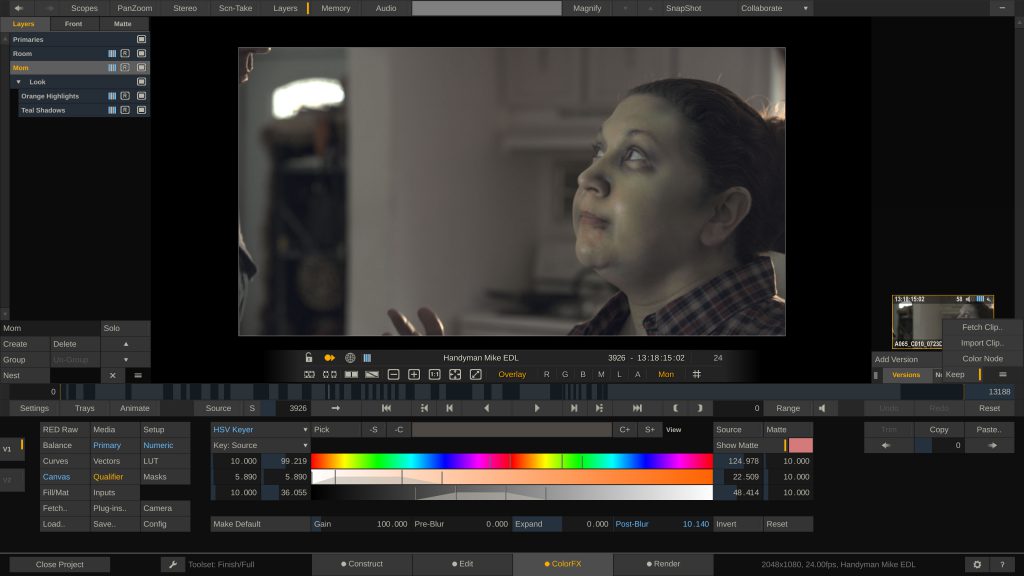Grading and Finishing with Scratch

Last summer I filmed a short mockumentary spoofing a home improvement show where the homeowners are a family of zombies. We shot this in a weekend with a fairly minimal crew, working with a first time director. The camera we filmed with was mine, a Red Epic-W, and we filmed in 8K raw.

Earlier this year after a lot of rounds of editing and screenings with test audiences, the editor sent me the final edit for color grading. At the time I was working on an IT contract in Seattle and commuting an hour each on the train, so I took my HP Spectre x360 and the hard drive and decided to get started while commuting.
The new v9 interface has a tab for importing footage, editing, color and FX, and delivery. It’s much more intuitive than navigation via right-click menu was.
Conform
The editor had given me an EDL and an XML file for conform, plus a reference render with timecodes. The EDL imported with the edits at the right points, but not the correct clips and clip timings. Some were correct, many were not.
Scratch’s reference video plays side by side with the original footage, so it ended up being pretty easy to update the timeline, aka CONstruct, with the correct edits. To add clips, you click “fectch” from the edit menu and retrieve a clip from the CONstruct you loaded it into. Other than that stage, editing the clip into place is pretty easy once you get used to Scratch’s odd editing modes.
The edit interface is getting an overhaul during the v9 product cycle. Assimilate isn’t planning to attempt to compete with a dedicated NLE, but does want to make conforming easier.
Grading
This is one of the areas where Scratch pretty much just gets out of the way and lets you work. Its interface is unintrusive and if you’ve used a color grading application before, sensible.

That said, there are some odd quirks here. One, the most obvious, is the extra trackballs labelled Color-A and Color-B. They both provide basically a hue shift and overall brightness control, and A takes place before the L-G-G controls, and B after. Assimilate is working on ways to make these more intuitive as part of the v9 product cycle.
Other than that, the tools are quite nice. The compositing tools are fairly basic; you’re not going to be using Scratch for careful, precise compositing effects that require careful Maynard-style keying, but it can do simple composites quite easily, making things like removing an overlooked branded water bottle from the set or replacing a sky quite simple.
One standout is Scratch’s keyers. It’s surprisingly easy to get clean keys in Scratch, which makes it very easy to key skin tones to grade them. Since the titular character was playing a human and his clients were zombies, I graded them differently; the zombies had green makeup on their faces, and Handyman Mike did not, I wanted to enhance the green slightly without adding green to Mike’s face. Scratch’s keyers made this suprisingly easy.
Delivery
The final film was just over five minutes long. Rendering the entire film on my laptop with just four cores and a 2GB Pascal GPU took around 20 minutes. It’s faster with my external GPU connected, but given that I was working with 8K footage, that was quite impressive. Final Notes
For color grading, Scratch does a great job of making it easy to be creative. Some of the things that Assimilate is planning to develop during the v9 cycle promise to improve the usability of the software as well as to add functionality. Some of what Assimilate is planning includes updated HDR oriented color tools and to enable rewiring the node tree, which will make working with more complex grades even easier.
Scratch also has a robust suite of dailies features including syncing by timecode and a semi-automatic sync by waveform, as well as features specific to 360 and VR that I haven’t explored in depth yet.
And finally, it’s surprisingly fast. Even working with 8K footage on a fairly modest laptop, it’s very responsive and the playback is surprisingly smooth.
All of that combined with very responsive customer service makes Scratch well worth a look.
Rakesh Malik, WinterLight Studios

Combining my love of nature photography with my love of storytelling has led to a distinctive cinema style where I strive to create images that tell stories on their own, even when they’re part of a sequence of moving images.
My photographs have been featured in print exhibitions in art galleries including the Louvre, and the film projects that I’ve worked on have been getting ever wider distribution though film festivals like SIFF.
When I’m not busy making movies, I love to go hiking and climbing. I’ve climbed two of Washington’s higest peaks and one of Africa’s, and intend to continue seeking to achieve more summits.
http://www.whitecranephotography.com/

